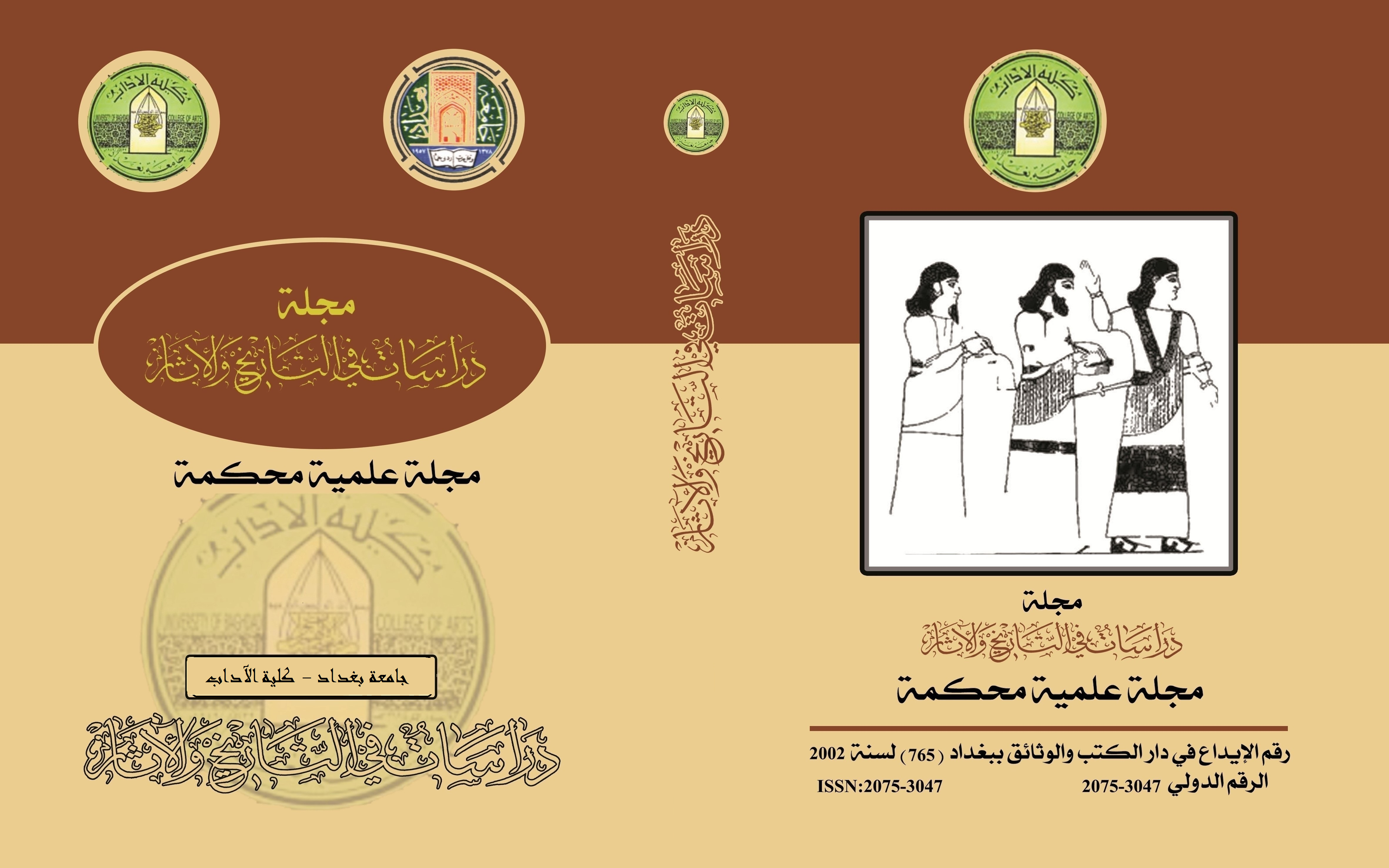الآراميون في جنوب بلاد وادي الرافدين
الكلمات المفتاحية:
آراميون، وادي الرافدين، كلديون، سوريا، عيلامالملخص
الاراميون أحد الشعوب الجزرية (السامية) التي هاجرت من الجزيرة العربية الى منطقة الهلال الخصيب. يتفق الباحثون على أن اول ذكر مؤكد للأراميين كان في الوثائق الاشورية من القرن الرابع عشر قبل الميلاد باسم اخلامو على امتداد نهر الفرات, وبعد ان استقروا في مدن اشير اليهم باسم ارامو.
عاش الاراميون في مناطق واسعة من بلاد الشام وشمال غرب العراق. بحدود 1200 ق.م، ونتيجة للفراغ السياسي في سوريا ظهر الاراميون كقوة سياسية فعاله في المنطقة، وفي مطلع الاف الأول كان تغلغلهم وضغطهم على شمال وادي الرافدين وبلاد اشور قويا.
اتجهت بعض القبائل الآرامية منذ القرن الحادي عشر قبل الميلاد نحو الجنوب واستقرت على امتداد نهري دجلة والفرات وكان لهم تأثير واضح بحيث أغتصبوا عرش بابل في هذا القرن ونصبوا عليها ملكاً ارامياً .
منذ أوائل القرن العاشر قبل الميلاد ظهرت العديد من الممالك او الدويلات الارامية واهمها: ارام صوبة وارام بيت رحوب في لبنان، وارام دمشق,حماة،وارباد، شمأل، بيت بجياني، وبيت اديني في سوريا. وكانت هذه الممالك مستمرة الصراع مع الدول المجاورة وفيما بينها بعض الأحيان.
وفي القرن الثامن قبل الميلاد وما بعده وبسبب الحملات الاشورية المستمرة على الدويلات الآرامية هاجر بعض من سكان هذه الدويلات باتجاه جنوب بلاد وادي الرافدين واستقروا مع ابناء جلدتهم الكلديين في مناطق حول بابل وجنوبها حتى الخليج العربي ، واستمر نفوذهما السياسي في تزايد وحالة من المد والجزر في صراعهما مع الاشوريين الى ان تمكن الكلديون ومعهم الاراميون من السيطرة على بابل وحكمها مدة تقارب القرن .
المراجع
(*) الجندي في ترجمته يذكر اسم شوازابو على أنه منطقة كلدية بينما البير ابونا يذكره على انه اسم ملك كلدي (ساكز ، 1999، ص146) (Saggs, 1999, P146)
المصادر العربية:
الكتاب المقدس: سفر التكوين .
أبو عساف ، علي (1988): الاراميون ، سوريا – طرطوس.
أحمد ، علي ياسين (دون تاريخ) "تكريت في العصر الاشوري الحديث" ، موسوعة مدينة تكريت، ج1.
باقر، طه (1973): مقدمة في تاريخ الحضارات القديمة ، ج1 ، بغداد.
جواد ، حسن فاضل (2001): حكمة الكلدانيين ، بغداد.
دوبونت- سومر (1988): الاراميون ، ترجمة ناظم الجندي ، سوريا – طرطوس.
دوبونت –سومر (2007) الاراميون ، ترجمة البير ابونا ، بغداد .
ساكز ، هاري (1999): قوة آشور ، ترجمة عامر سليمان ، بغداد.
ساكز، هاري (2009): البابليون ، ترجمة سعيد الغانمي، بيروت.
سوسه، أحمد (1981): العرب واليهود في التأريخ، بغداد.
شمعون ، غريغوريوس صليبا (1981)" الممالك الارامية ، حلب.
محمد ، حياة ابراهيم (1983): نبوخذ نصر الثاني 604-562 ق.م. ، بغداد .
References:
- The Bible: Genesis
- Abu Assaf, Ali (1988): The Aranaeans, Syria- Tartus.
- Ahmed, Ali Yasen (Without date): Tikrit in the New Assyrian Period, Encyclopedia Tikrit City Vol. I.
- Baqir, Taha (1973): Introduction in the History, of Ancient Civilisations, Vol. I, Baghdad.
- Dupont-Somer, (2007): The Arameaens, Trans. Albert Abona, Baghdad.
- Dupont-Somer, (1988): The Arameaens, Trans. Nadhum Al-Jundi, Syria- Tartus..
- Jawad, Hasan Ali (2001): The Kaldiansi Wisedom, Baghdad.
- Muhammed, Hayat Ibrahim (1983): Nabukhud Neser, II 604-562 B. C. Baghdad.
- Saggs, H. W. F., (1999): The Mighty of Assyria, Trans, Amer Sulayman, Baghdad.
- Saggs, H. W. F., (2009): The Babylonions, Trans, Saied
Al-Ghanimi, Beirut.
- Shamuon, Ghriguryus (1981): The Aramaean Kingdoms, Halab.
- Susa, Ahmed (1981): Arabs and Jews in the History, Baghdad.
المصادر الأجنبية: Foreign sources
Brinkman , J.A. , (1968): A Politicol History of Post-Kassite Babylonia 1158-722 B.C. , Rome.
Budg , E.A. , (1902): and King, L.W., The Annals of the Kings of Assyria , 1 , London.
Dringer , D. , (1962): Writing , London.
Dupont – Sommer , A., (1949): Les Arameens .
Grayson , A.K. , (1981): Assyrian Royal Inscriptions , Rome, 2 .
Grayson, (1975): Assyrian and Babylonian Chronicals , New York.
King, L.W., (1907): Chronicles Concerning Early Babylonian Kings ,2 Vols, London, 2,
Lambert W.G. , (1968): Journal of Ancient Oriental Studies, 88.
Luckenbill , (1926-1927): Ancient Records of Assyria and Babylonia , 2 vols , Chigacago.
Saggs , H.W.F. , (1980): Iraq 42.
Tadmor H. , (1958) Journal of Near Eastern Studies 17.
التنزيلات
منشور
إصدار
القسم
الرخصة

هذا العمل مرخص بموجب Creative Commons Attribution 4.0 International License.
:حقوق الطبع والنشر والترخيص
بالنسبة لجميع البحوث المنشورة في مجلة دراسات في التاريخ والآثار، يحتفظ الباحثون بحقوق النشر. يتم ترخيص البحوث بموجب ترخيص Creative Commons CC BY 4.0 المفتوح ، مما يعني أنه يجوز لأي شخص تنزيل البحث وقراءته مجانًا. بالإضافة إلى ذلك ، يجوز إعادة استخدام البحث واقتباسه شريطة أن يتم الاستشهاد المصدر المنشور الأصلي. تتيح هذه الشروط الاستخدام الأقصى لعمل الباحث وعرضه.
:إعادة إنتاج البحوث المنشورة من الناشرين الآخرين
من الضروري للغاية أن يحصل الباحثون على إذن لإعادة إنتاج أي بحث منشورة (أشكال أو مخططات أو جداول أو أي مقتطفات من نص) لا يدخل في نطاق الملكية العامة أو لا يملكون حقوق نشرها. يجب أن يطلب الباحثون إذنًا من مؤلف حقوق النشر (عادة ما يكون الناشر).
يطلب الإذن في الحالات التالية:
بحوثك الخاصة المنشورة من قِبل ناشرين آخرين ولم تحتفظ بحقوق النشر الخاصة بها.
مقتطفات كبيرة من بحوث أي شخص أو سلسلة من البحوث المنشورة.
استخدم الجداول والرسوم البيانية والمخططات والمخططات والأعمال الفنية إذا لم يتم التعديل عليها.
الصور الفوتوغرافية التي لا تملك حقوق لنشرها.
لا يطلب الإذن في الحالات التالية:
إعادة بناء الجدول الخاص بك مع البيانات المنشورة بالفعل في مكان آخر. يرجى ملاحظة أنه في هذه الحالة يجب عليك ذكر مصدر البيانات في شكل "بيانات من ..." أو "مقتبس من ...".
تعتبر عروض الأسعار القصيرة معقولة الاستخدام العادل ، وبالتالي لا تتطلب إذنًا.
الرسوم البيانية ، الرسوم البيانية ، المخططات ، الأعمال الفنية التي أعاد الباحث رسمها بالكامل والتي تم تغييرها بشكل ملحوظ إلى درجة لا تتطلب الاعتراف.
الحصول على إذن
لتجنب التأخير غير الضروري في عملية النشر ، يجب أن تبدأ في الحصول على أذونات في أقرب وقت ممكن. لا يمكن لمجلة الآداب نشر بحث مقتبس من منشورات أخرى دون إذن.
قد يمنحك مالك حقوق الطبع والنشر تعليمات بشأن شكل الإقرار الواجب اتباعه لتوثيق عمله ؛ بخلاف ذلك ، اتبع النمط: "مستنسخ بإذن من [المؤلف] ، [كتاب / المجلة] ؛ نشره [الناشر] ، [السنة]." في نهاية شرح الجدول ، الشكل أو المخطط.



















